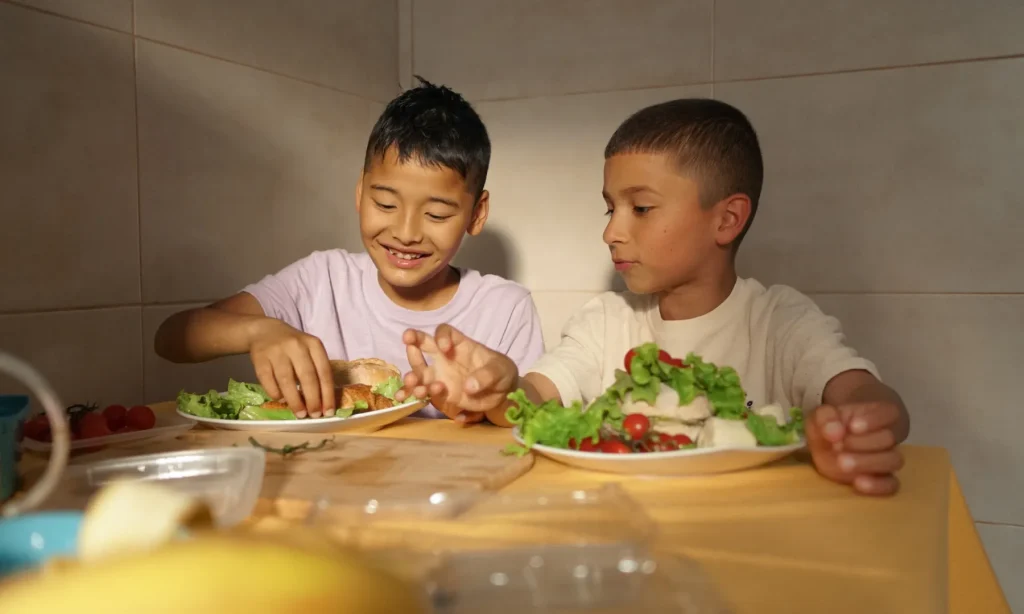For parents of children with tics, they have considered these questions one too many times—how food may be affecting tics? Is something as simple as what’s on their plate playing a part in why they struggle with tics? And they often feel frustrated by the lack of clear answers or overwhelmed by conflicting advice.
Conversations in holistic health circles have brought the gut-brain connection into the spotlight. Some families chose to consult with a tics disorder expert and confirmed their observation that certain foods seem to make their child’s tics flare up. Others swear by dietary changes for relief. But what’s the science behind it, and how much does diet truly matter when it comes to tic disorders? Let’s unravel the facts and explore how food might affect tics.
Key Takeaways
-
Food sensitivities, especially to gluten, dairy, artificial dyes, and preservatives, can trigger or worsen tics in some children, particularly those with related conditions like ADHD, OCD, or PANS/PANDAS.
-
The gut-brain connection plays a significant role; dietary triggers may cause delayed immune and inflammatory responses that impact tic frequency and severity.
-
Identifying individual food triggers requires careful tracking with food and tic diaries, as reactions can take 48–72 hours to manifest.
-
Eliminating inflammatory foods and optimizing nutrient-rich, whole-food diets often help reduce tics, but over-restricting or relying solely on supplements should be avoided.
-
Not all children with tics will respond to dietary changes, so professional guidance from a pediatrician or dietitian is crucial before making significant adjustments.
-
Complementary strategies such as behavioral interventions, managing co-occurring conditions, reducing stress, and limiting caffeine are vital for comprehensive tic management.
Table of Contents
Uncovering the Hidden Link Between Food and Your Child’s Tics
Let’s paint a picture: You’re sitting across from your child at dinner—spaghetti splatters on the table, ketchup smiley face on the plate. Suddenly, that eye twitch pops up again. Maybe there’s a repetitive eh-hem that can’t be chalked up to a cold. If you’re like most parents whose kids have tics, PANS/PANDAS, or Tourette’s, you’ve asked yourself: “Could his lunchbox be behind this?”
The Gut-Brain Tango—Why Food Might Matter
See, your child’s brain isn’t some separate fortress, high on a hill. It’s in constant conversation with the gut, what researchers call the gut-brain axis. If you’ve ever heard the phrase “second brain” tossed around on morning shows or Facebook mom groups, that’s what they mean: an entire ecosystem in the belly, chatting with the nervous system.
Scientists are just starting to crack the code, but one thing’s clear: certain foods—think artificial dyes, preservatives, and sometimes even innocent-seeming wheat or dairy—can stir up more than just a tummy ache. In some sensitive kids, they seem to ratchet up tics, especially if ADHD, OCD, or a history of immune trouble (like with PANS/PANDAS) is in the mix.
Parent Pitfall—Mistaking Tics for “Bad Habits”
It’s so easy to see a sniff or a shoulder jerk and think, “He’s just being silly.” Nope. Tics aren’t pretend or a cry for attention—they’re neurological hiccups that can flare up, especially after specific snacks. Before my friend Anna figured out her son’s dairy trigger, she found herself saying, “Stop that!” so many times, she lost count, and just felt more frustrated.
Real World Worries—How Food Plays Tricks
One afternoon, Anna swapped cheese sticks for carrot sticks. Within a week, her son’s blinking slowed, not gone, but better. Now, is this proof for every family? No. But anecdotal reports like Anna’s crop up in Facebook groups and doctors’ offices from coast to coast.
Cleaning Out the Pantry—Where to Start
You don’t need to turn into a short-order cook overnight or stock up on pricey “free-from” brands (unless that’s your jam). Start by keeping a food and an indicator diary for a couple of weeks. Write down everything: pancakes, goldfish crackers, even that surprise cupcake at school. When tics spike, jot the time—see if patterns emerge.
Sneaky culprits often include:
-
Artificial food dyes—think neon candies and fruity drinks (Red 40, we’re looking at you)
-
Preservatives—like sodium benzoate, hiding in sodas or pickles
-
Gluten and dairy—biggies for kids with PANS/PANDAS or sensitive guts
Weird tip? Some parents swear by “real food swaps”—think apple slices for cookies or making your trail mix with plain Cheerios and nuts.
The Science and the Skepticism
Official research is catching up, with small but hopeful studies hinting that cutting certain foods may help some children. But here’s the sticky bit: no two kids are wired alike. What sparks a runaway train of tics in one can be a non-issue for another. The American Academy of Pediatrics acknowledges the link, albeit somewhat tentatively, by stating that more research is needed.
Gut Checks You Can Do Tonight
Not ready to overhaul your pantry? Start small by skipping colorful, dyed snacks for a week and observe any changes. If your child’s tics worsen after eating certain meals, like dairy-heavy dishes, try removing that food for a week to test its impact. Small changes can lead to significant insights.
Be cautious about advice from forums or “natural remedies” blogs—stick to trusted sources. Many parents have found that exploring potential food triggers saves them stress and money. If overwhelmed, consult a knowledgeable pediatrician about tics, ADHD, and food sensitivities. Food might not be the whole story, but it could play a part. Pay attention; the answer could be right on the plate.

What Causes Tics and Who Is Affected?
Tics can show up as odd, sudden noises or jerky movements, sometimes as blinking or throat-clearing, sometimes as whole-body twists, all without warning.
Prevalence
If you think your family’s alone in this, let’s pop that myth like a birthday balloon. Up to 20% of school-aged kids have tics at some point—picture five kids on the playground, and odds are one’s got a tic, if only for a few months. For Tourette’s syndrome, a recognition sticks for somewhere between 0.4% and 3.8% of children—so, more likely than catching red hair but less common than a peanut allergy in most classrooms. You probably know someone with tics and don’t even realize it.
Impact
Tics can trip up more than just your child’s concentration. For some kids, repeated head jerks or outbursts feel like popcorn kernels stuck under the skin—itchy, bothersome, impossible to ignore. Classmates might stare. Teachers might misunderstand, thinking it’s bad manners or wild energy. And when ADHD or OCD join the scene , life’s social scenes get trickier—simple jokes or classroom requests can suddenly lead to an avalanche of embarrassment, frustration, or even tears.
Functional Medicine Perspective
Now let’s toss the recommendation pads aside for a second—functional medicine thinks outside that little orange bottle. Instead of just squashing the signs, this approach plays health detective, digging into possible root causes: food sensitivities, gut inflammation, nutrient gaps, even hidden infections.
Ever wondered if last night’s mac ‘n’ cheese extravaganza sparked today’s tics? Functional docs do, too. They’ll look at everything from gluten to artificial dyes to see if something in your child’s diet is worsening tics. The goal is to quiet down those tics—not just with a pill, but by dialing down the trigger itself. Some parents tell me their kitchen experiments worked wonders, trimming tics faster than you’d believe. Others need more than avocado toast and magnesium before the calm kicks in.
How Food May Be Affecting Tics: The Science Explained
Food sensitivities, tics, and your kid’s well-being are all tangled together in ways most folks don’t see. Have you ever noticed your child’s tics seem to spike mysteriously, days after a pizza party or a birthday cake bonanza? For some kids, the “why” circles all the way back to their immune system’s reaction to what’s on their plate.
The Inflammation-Tic Connection
Let’s paint the picture. Imagine your child as a vibrant city—gut neighborhoods and brain business districts all bustling and calling each other up every day. When certain foods (think gluten, dairy, maybe eggs or peanuts) sneak onto the menu, their immune system can spring into action. But it’s not the SWAT-team allergy reaction you’d spot with a peanut or bee sting—this is a slow-burning response. It coughs up sneaky inflammatory messengers (cytokines) that roam the bloodstream, eventually crashing the delicate signaling in the brain’s CSTC loop—a circuit famous for keeping tics in check.
If your child’s sensitive, that bowl of mac and cheese or a glass of chocolate milk may trip this invisible alarm. Maybe you catch it as a burst of extra blinking, shoulder shrugs, or that non-stop throat-clearing. Or maybe emotions zip up—sudden anxiety, meltdowns over assignments, even perfectionist streaks out of nowhere. And let’s not gloss over sugar; it nudges dopamine up and down, affecting your child’s mood.
Key Entities in Food Sensitivities and Tics
Some tics, often linked with conditions like ADHD, OCD, PANS, and PANDAS, can be triggered by food sensitivities. Common culprits include gluten, dairy, sugar, and artificial ingredients. These sensitivities may lead to symptoms like eye blinking, throat clearing, or vocal outbursts. The connection involves complex biological processes like inflammation and dopamine issues, but you don’t need medical expertise to observe changes.
Families often use elimination diets—removing potential triggers and gradually reintroducing them—to identify problem foods. While results are not guaranteed, this approach is worth a try. Many parents find improvements, such as fewer disruptive tics, by cutting out problematic foods.
What Everyone Gets Wrong About Food and Tics
Tics may not always stem solely from brain issues. Food sensitivities can trigger immune responses that worsen tics, sometimes days after eating. Delayed gut-brain communication means tic triggers may not show immediate effects, making it tricky to pinpoint specific foods. Standard approaches like medication and therapy aren’t the only options. Cutting artificial additives or focusing on nutrient levels—like magnesium, zinc, and vitamin B6—can help reduce tics by addressing underlying causes instead of just symptoms.
Most times, it’s about filling nutritional gaps, not just avoiding problem foods. The emotional toll is significant too—kids may feel isolated or stressed, especially when unable to enjoy typical social foods like pizza or cake. This stress can worsen tics, creating a cycle that might be broken by starting with gut health, not just targeting the brain.
Pro Tip: Try this challenge—pick a single trigger suspect (like gluten, dairy, or artificial dyes), drop it for two weeks, and log how tics shift on a calendar or even a sticky note on the fridge.

Step-by-Step Guide to Managing Tics Through Diet
Let’s explore how changing what your child eats might reduce their tics. If you’ve ever wondered if choosing healthier snacks over processed ones could make a difference, this guide is for you. It’s packed with practical, parent-tested tips to transform your kitchen and boost your child’s confidence.
Step 1: Identify Potential Food Triggers
Keep a detailed food journal, noting everything your child eats—like Goldfish, strawberry milk, or mac and cheese. Pay special attention to common triggers such as gluten, dairy, sugar, and foods with dyes or preservatives.
Remember, reactions to foods can take up to 72 hours, so a tic on Wednesday might trace back to Sunday’s pizza. Some parents use IgG sensitivity tests, but trying an elimination diet works too. Cut out gluten or dairy for two weeks, then reintroduce foods one at a time to spot triggers.
Step 2: Eliminate Inflammatory Foods
Removing certain foods can reduce tics. In my home, cutting out wheat bread, traditional cereal, dairy milk, and sugary juices (like those with Red 40) left the fridge bare, but within two weeks, my son’s tics improved significantly.
Here’s why: gluten, dairy, and sugar can increase inflammation and disrupt brain signals, particularly in kids with conditions like PANS/PANDAS or Tourette’s. Reducing these foods helps prevent a cascade of symptoms, though sugar is the hardest to quit. Even organic gummies can spark tic-related dopamine spikes. Try alternatives like homemade smoothies and check labels—sugar hides everywhere, even in ketchup!
Step 3: Optimize Nutrient-Dense Foods
Switch processed foods for nutrient-rich options to help manage tics. Incorporate colorful, real foods like spinach, sweet potatoes, chicken, avocado, and berries. Nutrients like magnesium, B6, and zinc support muscles, brain signals, and inflammation. Try meals like turkey sausage with spinach, chicken salad with olive oil, and salmon with quinoa for simple, nourishing choices.
Step 4: Consider Supplements with Caution
Some parents explore NAC (N-acetylcysteine) to reduce tics, though research shows mixed results, so it’s not guaranteed. DPP-IV enzymes might help kids digest gluten or casein from unexpected treats, but consult a professional first for safety. Focus on whole foods and seek expert guidance before trying new supplements.
Step 5: Monitor and Adjust
Tracking tics can provide clear, measurable insights, much like a growth chart. If no changes occur after a month, consider possible triggers like hidden treats, sugary drinks, stress, or other factors. When in doubt, consult professionals, as it might not just be food causing the issue but overwhelm as well.
Summary Table: Step-by-Step Dietary Management for Tics
|
Step |
What You Do |
Example/Tip |
|---|---|---|
|
1 |
Identify Triggers |
Track meals, log tic signs, try food journals + phone pics |
|
2 |
Eliminate Inflammatory Foods |
Scrap gluten, dairy, dyes, sugar—read every label! |
|
3 |
Optimize Nutrients |
Up greens, lean meats, nuts, seeds for brain boost |
|
4 |
Consider Supplements |
Check with holistic MD, weigh NAC/DPP-IV, go slow |
|
5 |
Monitor & Adjust |
Use YGTSS, watch for non-food triggers, stay flexible |
It might feel impossible at times, but stick with it. Some of the calmest weeks we’ve ever had started in the kitchen, not the pharmacy.
Common Mistakes to Avoid When Addressing Food Sensitivities
If your child’s tics worsen after meals, identifying food triggers can sound like a lot of work. Many parents struggle with hidden ingredients like artificial additives (e.g., yellow No. 5). Avoid common mistakes by learning how to address food sensitivities effectively.
Ignoring Delayed Reactions
Tic reactions to food sensitivities can take up to 2–3 days to appear, so it’s essential to look beyond the same day of eating a suspected trigger food. To identify patterns, keep a detailed food and symptom diary for at least a week. This approach helps uncover triggers and reduces frustration.
Over-Restricting Diets
Parents often rush to eliminate entire food groups to quickly address tics, cutting out things like gluten, dairy, and other enjoyable foods. However, growing bodies need variety, and removing too many foods can leave kids feeling tired, irritable, and fixated on the excluded items.
Think nutrient density first. Instead of building a “No List” a mile long, ask what nourishing, delicious stuff you can add in. Aim for color, crunch, protein, and yes—some joy on the plate. Stick with whole foods when possible. If you’re tempted to cut something significant, talk to a pro before making it a long-term thing.
Relying Solely on Supplements
Supplements like magnesium, B6, and fish oil can help, but they’re not a cure-all if the diet is still full of processed foods like crackers and soda. They’re meant to fill gaps, not solve everything. Focus on providing real, nutrient-rich meals instead of relying solely on supplements. They also can’t replace proper sleep or balance in life. For example, giving a probiotic after a week of junk food won’t help and can end up being a waste of money.
Skipping Professional Guidance
Dr. Google is tempting, but it’s essential to consult an expert on tic disorders for accurate advice. Food sensitivities can mimic allergies or other issues, and additional factors like PANS/PANDAS or vitamin deficiencies might be involved. Testing doesn’t have to be daunting or expensive—a dietitian or pediatrician can guide you. Many clinics now offer payment plans or group sessions, so explore your options.
Pro Tips: Keep Your Cool, Embrace the Process
-
Don’t panic over every flare-up. Some days are just louder than others.
-
Invite your kid into the process. Taste tests, sticker charts, silly meal themes—it can be fun.
-
Remember, progress isn’t linear. There’ll be “aha!” moments and confusing detours.
-
Celebrate small wins. That first quiet car ride or school day with fewer tics? That’s huge.

Complementary Strategies: Beyond Diet
Snacks are handled, but tics remain persistent. Don’t worry—food is just the starting point. Let’s explore bigger solutions beyond the kitchen.
Behavioral Interventions
Ever wish you could make your child’s tics take a break? While there’s no magic fix, Comprehensive Behavioral Intervention for Tics (CBIT) can help. It’s like brain coaching—teaching kids to replace tics with more subtle actions. Another tip: educate those in your child’s life. A simple note to teachers or coaches explaining tics and how to handle them can make things much easier and less awkward for everyone.
Managing Co-Occurring Conditions
Tics often come with conditions like ADHD or OCD, making daily routines challenging. Non-stimulant medications like guanfacine may help with both tics and attention issues, improving daily life by about 37%*. Cognitive-behavioral therapy (CBT) is effective for obsessive thoughts, offering kids tools to manage them. Parents have noticed improvements in routines, especially with the support of a child psychologist, small but meaningful progress over time.
Lifestyle Factors
Many parents notice that stress can make tics worse. Simple stress-reducing activities like short yoga sessions, mindfulness exercises, or breathing can help kids stay calm. Also, watch out for caffeine—it often worsens tics in children and can be hidden in unexpected places like energy drinks, sodas, chocolate milk, or iced tea.
Your Next Steps to Reduce Tics Naturally
If you’re ready to explore how food sensitivities might be affecting your child’s tics, start with small, manageable changes. Keep a detailed food diary and pay close attention to patterns between what your child eats and any changes in their behavior or symptoms.
Don’t hesitate to reach out to tic disorder experts who understand the gut-brain connection and can guide you through safe dietary adjustments. Remember, every child is different, so patience and persistence are key as you find what works best for your family.
Support and community can make a big difference in this journey. Connecting with other parents and sharing experiences can help you stay motivated and confident as you continue seeking solutions for your child’s well-being.
If you are ready to dig deeper into your child’s tic disorder, click here and start with the Tic Disorder Cheat Sheet.
Frequently Asked Questions
Food sensitivities can worsen tics in kids with disorders like Tourette’s by causing delayed immune responses that affect the brain. Unlike allergies, which trigger immediate reactions, sensitivities lead to inflammation from a leaky gut, allowing toxins to enter the bloodstream. Research shows that up to 70% of children may experience symptom relief through dietary changes, such as eliminating dairy or gluten, thereby improving gut health without relying solely on medication.
Food allergies can cause quick, severe reactions, such as hives or swelling, through an IgE-mediated immune response. Sensitivities, however, involve delayed IgG reactions, leading to subtle issues like mood swings, inflammation, or tic flare-ups days later. They’re often linked to gut problems and can be managed by avoiding triggers, unlike allergies, which require strict avoidance to prevent emergencies.
Yes, enhancing gut health can ease tics for many kids. Leaky gut allows undigested food and toxins to enter the bloodstream, triggering immune reactions that impact neurology. Dietary tweaks, such as removing inflammatory foods like gluten or additives, plus better sleep and stress management, may help up to 70% of children. Tracking with a food diary reveals patterns and guides changes.
Common triggers include dairy, gluten, artificial additives, corn, and eggs. These can inflame the gut, leading to leaky gut and delayed reactions that worsen tics or mood. Not all kids react the same—some might be sensitive to processed foods or preservatives. Start by eliminating one at a time and use a journal to spot links between meals and symptoms.
Keep a detailed food diary tracking meals, snacks, and tic patterns over days, as reactions can be delayed. Test one ingredient at a time, like removing dairy for a week. If tics persist, consider IgG food sensitivity testing to uncover hidden triggers. Combine these observations with stress, sleep, and infection data for a comprehensive picture.
Leaky gut occurs when the gut lining becomes inflamed and permeable, allowing undigested particles and toxins to enter the bloodstream. This triggers immune responses that can inflame the brain, exacerbating tics. Factors such as antibiotics, stress, or a poor diet contribute. Addressing symptoms through anti-inflammatory foods and lifestyle changes may help alleviate symptoms in sensitive children.
Sensitivities can develop over time due to repeated exposure to inflammatory foods, antibiotics, or stress, often manifesting around ages 5-6. Early gut damage leads to leaky gut, amplifying reactions. Genetic and environmental factors play a role, but proactive tracking and dietary changes can prevent escalation and manage tics effectively.
Yes, IgG testing can reveal hidden triggers that trial and error may miss, such as gluten or dairy, which can cause delayed responses. It’s like detective work—Harvard research links gluten to gut issues affecting tics. Combine with a food journal for optimal results, enabling tailored plans to alleviate symptoms.
References
Scahill L, Specht M, Page C. The prevalence of tic disorders and clinical characteristics in children. J Obsessive Compuls Relat Disord. 2014;3:394–400. doi:10.1016/j.jocrd.2014.06.002. https://www.ncbi.nlm.nih.gov/pmc/articles/PMC4339029/
Ludlow AK, Rogers SL. Understanding the impact of diet and nutrition on symptoms of Tourette syndrome: A scoping review. J Child Health Care. 2018;22(1):68–83. doi:10.1177/1367493517748373. https://www.ncbi.nlm.nih.gov/pubmed/29268699
*Scahill L, Chappell PB, Kim YS, et al. A placebo-controlled study of guanfacine in the treatment of children with tic disorders and attention deficit hyperactivity disorder. Am J Psychiatry. 2001;158(7):1067–1074. doi:10.1176/appi.ajp.158.7.1067. https://psychiatryonline.org/doi/10.1176/appi.ajp.158.7.1067

